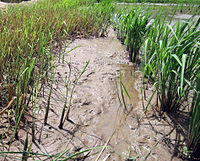
Photo from wikipedia
The development of rice cultivars with nutrient use efficiency (NuUE) is highly crucial for sustaining global rice production in Asia and Africa. However, this requires a better understanding of the… Click to show full abstract
The development of rice cultivars with nutrient use efficiency (NuUE) is highly crucial for sustaining global rice production in Asia and Africa. However, this requires a better understanding of the genetics of NuUE-related traits and their relationship to grain yield. In this study, simultaneous efforts were made to develop nutrient use efficient rice cultivars and to map quantitative trait loci (QTLs) governing NuUE-related traits in rice. A total of 230 BC1F5 introgression lines (ILs) were developed from a single early backcross population involving Weed Tolerant Rice 1, as the recipient parent, and Hao-an-nong, as the donor parent. The ILs were cultivated in field conditions with a different combination of fertilizer schedule under six nutrient conditions: minus nitrogen (–N), minus phosphorus (–P), (–NP), minus nitrogen phosphorus and potassium (–NPK), 75% of recommended nitrogen (75N), and NPK. Analysis of variance revealed that significant differences (p < 0.01) were noted among ILs and treatments for all traits. A high-density linkage map was constructed by using 704 high-quality single nucleotide polymorphism (SNP) markers. A total of 49 main-effect QTLs were identified on all chromosomes, except on chromosome 7, 11 and 12, which are showing 20.25% to 34.68% of phenotypic variation. With further analysis of these QTLs, we refined them to four top hotspot QTLs (QTL harbor-I to IV) located on chromosomes 3, 5, 9, and 11. However, we identified four novel putative QTLs for agronomic efficiency (AE) and 22 QTLs for partial factor productivity (PFP) under –P and 75N conditions. These interval regions of QTLs, several transporters and genes are located that were involved in nutrient uptake from soil to plant organs and tolerance to biotic and abiotic stresses. Further, the validation of these potential QTLs, genes may provide remarkable value for marker-aided selection and pyramiding of multiple QTLs, which would provide supporting evidence for the enhancement of grain yield and cloning of NuUE tolerance-responsive genes in rice.
Journal Title: International Journal of Molecular Sciences
Year Published: 2019
Link to full text (if available)
Share on Social Media: Sign Up to like & get
recommendations!